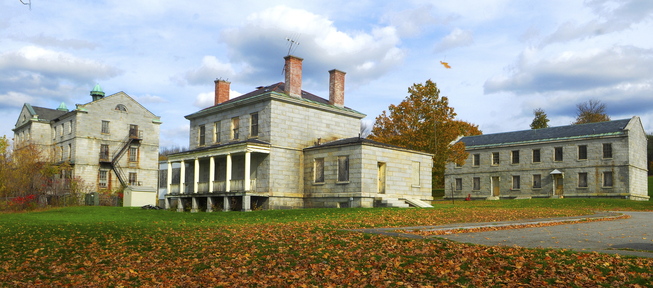AUGUSTA — New roofs top several of the historic Kennebec Arsenal buildings that otherwise stand idle along the Kennebec River, awaiting private development.
The roofing work is the most visible, but not the only, improvement made to the property recently by contractors working for would-be Arsenal developer Tom Niemann, a North Carolina man who bought the property from the state in 2007. It is a designated National Historic Landmark that has been described as among the state’s most endangered historic properties.
While a lawsuit filed by the state against Niemann’s companies alleging he has failed to maintain or preserve the property still looms, state officials have been in communication with Niemann as he has had work done on the property to make sure it meets historic preservation standards. Also, lawyers for both the state and Niemann have agreed to extend deadlines related to the lawsuit as they seek an alternative resolution to the litigation.
Meanwhile, workers are taking steps to make six of the seven primarily stone-walled buildings tucked between the former Augusta Mental Health Institute campus and the Kennebec River secure from vandals and weather-tight. Buildings with new roofs include the small gatehouse and larger commandant’s quarters, and the riverfront North Burleigh. The portion of the South Burleigh building’s roof that is covered with shingles has been replaced, and the slate portion is due for repair this week. Officials said the barracks building’s slate roof also will be repaired this week. The roof of the Old Max building was in good enough shape that it didn’t need to be replaced.
Kathleen “Sukey” Sikora, an Augusta resident who is working as Niemann’s project leader at the arsenal, said after this week every building at the complex other than the large, stately, but neglected, Burleigh building will have a good roof.
“What we’re focusing on now is preservation, not development, first,” said Sikora, who said she is in constant communication with Niemann. “Getting the buildings so they’re secure and weather-tight.”
That has included the new roofs as well as sealing windows, some of which have new glass; others are covered with boards.
Sikora said work on the big Burleigh building is on hold at least until masonry that is at risk of falling off is made safe. She said the building will need a significant amount of work.
State officials said the lawsuit will continue.
“While the state is pleased Mr. Niemann has been making some necessary repairs following the filing of our lawsuit, there is still much work that needs to be done,” said Jennifer Smith, director of legislative affairs and communications for the state Department of Administrative and Financial Services. “The state is scheduled to have a supervised mediation session on this matter later this month and will continue the lawsuit and discussions to resolve the issues at the arsenal as appropriate.”
Other work completed at the arsenal, according to Sikora, included new basement steps, a door and floor jacks to stabilize the gatehouse until more structural work can take place at the building, which Niemann plans to renovate soon into offices for his firm.
“The gatehouse was literally collapsing, because of a gaping hole in the roof and bad drainage that made the basement a swamp,” Sikora said. “So the gatehouse has been saved.”
Work also included the restoration of electricity to the gatehouse, the commandant’s quarters and Old Max. That allows security cameras to function and keep an eye on the property, which has been hit by extensive vandalism, including the removal of copper piping.
“Copper thieves did a number on this whole complex,” Sikora said. “For $400 worth of copper, they did $80,000 in damage.”
Sikora said after work on the gatehouse is complete, which could be within a couple of months, the building most ready for development is the barracks, which was used for state offices more recently than the other arsenal buildings. She said the plan for the barracks, which could change if tenants express interest in something different, is to develop two residential units upstairs and office or retail space on the first floor.
However, the unresolved lawsuit, which the state filed after years of officials’ frustration that Niemann wasn’t developing, maintaining or preserving the property to their liking, remains a factor. The lawsuit seeks to compel Niemann to maintain the property or, if he cannot, possibly to have the property turned back over to the state.
“The lawsuit is hampering progress,” Sikora said. “Investors and tenants are skittish because of it, but Tom is confident that will be resolved once they see how much preservation work has been done.”
In a motion approved Oct. 21 by Justice Michaela Murphy, lawyers for both sides agreed to postpone scheduled mediation of the lawsuit for 40 days, to Nov. 25, as discussions toward a resolution continues, and have until Dec. 4 to complete the mediation.
“The parties have been engaged in significant discussions relating to potential resolution of this matter and are working to narrow the issues that exist between them,” the motion states.
Sikora said Mike Johnson and other officials from the Maine Historic Preservation Commission have been helpful, approving work to make sure it is up to historic preservation standards, and assisting her in dealing with related “red tape.”
She said the work has been expensive, but that Niemann did not want to disclose specifics about the cost.
The arsenal is considered by some preservationists to be one of the best and earliest surviving examples of 19th-century munitions depots in the country.
It was built from 1828 to 1838.
In August, Maine Preservation designated the property as among the state’s most endangered historic properties.
Keith Edwards — 621-5647
kedwards@centralmaine.com
Send questions/comments to the editors.





Comments are no longer available on this story